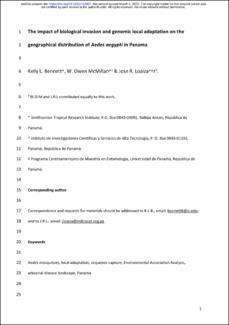| dc.contributor.author | Bennett, Kelly L. | |
| dc.contributor.author | McMillan, W. Owen | |
| dc.contributor.author | Loaiza, Jose R. | |
| dc.date.accessioned | 2020-07-02T02:39:54Z | |
| dc.date.available | 2020-07-02T02:39:54Z | |
| dc.date.issued | 2019-01-01 | |
| dc.identifier.other | https://doi.org/10.1101/744607 | |
| dc.identifier.uri | http://repositorio-indicasat.org.pa/handle/123456789/153 | |
| dc.description | Local adaptation is an important consideration when predicting arthropod-borne disease risk because it can impact on vector population fitness and persistence. However, the extent that vector populations are adapted to local environmental conditions and whether this can impact on species distributions generally remains unknown. Here we find that the geographic distribution of Ae. aegypti across Panama is rapidly changing as a consequence of the recent invasion by its ecological competitor, Aedes albopictus. Although Ae. albopictus has displaced Ae. aegypti in some areas, species coexist across many areas, raising the question: What biological and environmental factors permit population persistence?. Despite low population structure and high gene flow in Ae. aegypti across Panama, excepting the province of Bocas del Toro, we identify 128 candidate SNPs, clustered within 17 genes, which show a strong genetic signal of local adaptation. This putatively adaptive variation occurs across relatively fine geographic scales with the composition and frequency of candidate adaptive loci differing between populations in wet tropical environments along the Caribbean coast and the dry tropical conditions typical of the Pacific coast of Panama. Temperature and vegetation were important predictors of adaptive genomic variation in Ae. aegypti with potential areas of local adaptation occurring within the Caribbean region of Bocas del Toro, the Pacific coastal areas of Herrera and Panama City and the eastern Azuero Peninsula. Interestingly, several of these locations coincide with areas where Ae. aegypti and Ae. albopictus co-exist, suggesting that Ae. aegypti could have an adaptive edge under local environmental conditions that impacts on inter-specific competition with Ae. albopictus. Our results guide future experimental work by suggesting that locally adapted Ae. aegypti are able to persist on invasion by Ae. albopictus and, as a consequence, may fundamentally alter future arborviral disease risk and efforts to control mosquito populations. | en_US |
| dc.description.abstract | Local adaptation is an important consideration when predicting arthropod-borne disease risk because it can impact on vector population fitness and persistence. However, the extent that vector populations are adapted to local environmental conditions and whether this can impact on species distributions generally remains unknown. Here we find that the geographic distribution of Ae. aegypti across Panama is rapidly changing as a consequence of the recent invasion by its ecological competitor, Aedes albopictus. Although Ae. albopictus has displaced Ae. aegypti in some areas, species coexist across many areas, raising the question: What biological and environmental factors permit population persistence?. Despite low population structure and high gene flow in Ae. aegypti across Panama, excepting the province of Bocas del Toro, we identify 128 candidate SNPs, clustered within 17 genes, which show a strong genetic signal of local adaptation. This putatively adaptive variation occurs across relatively fine geographic scales with the composition and frequency of candidate adaptive loci differing between populations in wet tropical environments along the Caribbean coast and the dry tropical conditions typical of the Pacific coast of Panama. Temperature and vegetation were important predictors of adaptive genomic variation in Ae. aegypti with potential areas of local adaptation occurring within the Caribbean region of Bocas del Toro, the Pacific coastal areas of Herrera and Panama City and the eastern Azuero Peninsula. Interestingly, several of these locations coincide with areas where Ae. aegypti and Ae. albopictus co-exist, suggesting that Ae. aegypti could have an adaptive edge under local environmental conditions that impacts on inter-specific competition with Ae. albopictus. Our results guide future experimental work by suggesting that locally adapted Ae. aegypti are able to persist on invasion by Ae. albopictus and, as a consequence, may fundamentally alter future arborviral disease risk and efforts to control mosquito populations. | en_US |
| dc.language.iso | eng | en_US |
| dc.rights | https://creativecommons.org/licenses/by-nc-sa/4.0/ | |
| dc.rights | info:eu-repo/semantics/openAccess | |
| dc.subject | Aedes mosquitoes | en_US |
| dc.subject | local adaptation | en_US |
| dc.subject | sequence capture | en_US |
| dc.subject | Environmental Association Analysis | en_US |
| dc.subject | arboviral disease landscape | en_US |
| dc.subject | Panama | en_US |
| dc.title | The impact of biological invasion and genomic local adaptation on the geographical distribution of Aedes aegypti in Panama | en_US |
| dc.type | info:eu-repo/semantics/article | en_US |
| dc.type | info:eu-repo/semantics/publishedVersion | |

